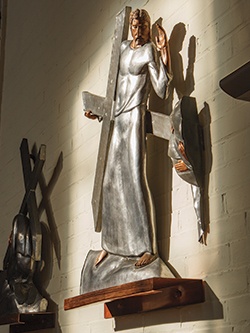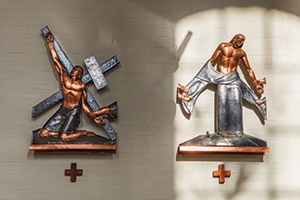
One of the oldest and most beloved of Christian devotions is the Way of the Cross, commemorating the journey of Jesus through the streets of Jerusalem to Golgotha and his crucifixion and death. After the acceptance of Christianity by Constantine in 312 C.E., pilgrims freely traveled to the Holy Land to walk in the footsteps of Jesus, stopping to pray and reverence the sites associated with his passion. The journal of Egeria, a fourth-century woman from Galicia, recounts the rituals of Holy Week including the veneration of relics, the offering of prayers, the reading of scripture and the singing of psalms at each stop along the Via Dolorosa. Originally the route began at the end of the journey: starting at the Church of the Holy Sepulcher and travelling back to the house of Pilate. When Palestine was conquered by the Turks in the seventh century and travel to Jerusalem became dangerous, there were attempts to recreate the pilgrim experience in Europe. But it was not until the fourteenth century, when the Franciscans were granted custody of the Christian sites in Jerusalem, that the Stations were represented throughout Europe by various artistic means and became popular with the faithful, especially as a Lenten observance. This devotional practice complemented medieval Christian spirituality with its focus on the suffering Christ. Over the centuries the number of Stations varied, although fourteen came to be the standard number, only eight of which are based on the Gospel narrative. The definitive term “Stations” was first used by William Wey, an English pilgrim who made visits to the Holy Land in the fifteenth century. The first Stations were established out of doors as little shrines and later were installed in monastery chapels. Eventually they became a part of every parish church, as familiar as statues and stained glass windows.
We at STM are privileged to have adorning the side walls of our Chapel a beautiful depiction of the Fourteen Stations rendered in copper and lead by the liturgical artist Robert Amendola '33 B.F.A. He was born on April 24, 1909 in Boston, studied at the Massachusetts College of Art, received his B.F.A. from Yale School of Art in 1933 and subsequently pursued graduate studies at the American Academy in Rome. In 1935, he received the coveted Prix de Rome in Visual Arts. A sculptor and teacher, he served on the faculties of the School of Fine Arts in Worcester, MA; Emmanuel College in Boston; Boston College and the University of Notre Dame. Amendola’s work is found in parish churches and convent chapels throughout Massachusetts and Connecticut, and on college and university campuses. Among his notable creations are the statue of Our Lady of Good Counsel in the Bapst Library of Boston College, the art works in the Catholic Chapel at the University of Connecticut and the Stations of the Cross at STM. A secular sculpture of the young George Washington Carver is located at the George Washington Carver National Monument in Diamond, MO.
Amendola’s Stations were installed at the time of the dedication of the Chapel in 1938 and were given by William and Elizabeth Pool in memory of their sons, Crowell Hadden III and Briton Hadden. They complement the original, and now restored, chandeliers both in materials and in the Art Deco style of the period. Although the designation “Art Deco” came into use decades later, the term originated from the Exposition Internationale des Arts Decoratifs et Industriels in Paris in 1925. Influenced by earlier artistic styles—Greco-Roman (ideals of proportion and balance), Egyptian (two-dimensional silhouette) and Asian (shiny, glossy finish)—Art Deco was the predominant global style of the 1920s and 30s. Amendola’s work gives evidence of the abstraction of form and simplification of line consonant with the Art Deco style. Gerald York '81, sculptor and STM community member, speculates that, in creating his Stations, the artist hammered the copper and lead over wooden forms. In his use of planes and geometric forms, the artist was able to show the material as it really is. As viewers, we experience the copper and lead as smooth, shiny and sinuous. Each Station is positioned on a highly polished copper base or shelf. Some years ago, during a refurbishing of the Chapel, the Stations were re-polished by the artist and raised to a higher position on the walls. A distinctive feature of Amendola’s work is his use of disembodied hands in most of the Stations, representing the faithful who are complicit in the passion and death of Christ. This “visual theology” speaks of the participation of humankind throughout the ages in the crucifixion.

The Eighth Station: Jesus meets the women of Jerusalem.
Located on the right wall between the etched glass windows of St. Benedict to the left and St. Ives to the right, is the Eleventh Station:
Jesus is Nailed to the Cross. The figure of Christ on his knees is not bowed down in agony or humiliation; his upper torso is straight
and firm. It is a strong, resolute and determined posture. His gaze is heavenward, fully committed to accomplishing the will of God.
His right hand is outstretched on the right arm of the Cross, which forms a diagonal plane dividing the scene into quadrants. His left
hand is held by one disembodied hand just at the moment before the nail pierces human flesh. Another hand grasps the wood of the
cross. According to the theology of atonement prevalent at the time of Amendola’s creation of the Stations, Christ’s sacrificial death
atoned for the sinfulness of humanity. A more contemporary interpretation of the death of Christ, seen through the lens of
feminist and liberation theology, would view the crucifixion as the inevitable result of the rejection of Jesus’s prophetic proclamation
of the Kingdom of God. And his embodiment of human suffering emphasizes Christ’s compassion for, and identification with, the
poor and the marginalized across the globe. A close reading of Amendola’s depiction of this Station might reveal a synthesis of both
atonement theology and liberation theology. The nail driven into Christ’s right hand clearly implicates human sinfulness as the cause of
his passion and death. Perhaps the disembodied hands proximate to his left hand are providing comfort and consolation to Christ while
engaging in an act of solidarity with the marginalized and oppressed—as Christ himself is doing.

Eleventh Station: Jesus is Nailed to the Cross. The figure of Christ on his knees is not bowed down in agony or humiliation; His upper torso is straight and firm. It is a strong, resolute and determined posture.
Works Referenced:
www.catholicnewsagency.com/...stations¬_of_the_cross from the Catholic Times. Accessed March 19, 2018.
“The Biography of Robert Amendola.” ArtPrice.com. Accessed March 19, 2018.
Saxon, Wolfgang. “Obituary of Robert Amendola.” New York Times, January 12, 1996.
With gratitude to Peter Alegi '56 '59 LL.B.; Genevieve Coyle; Attilio Granata '74 M.D. '77; Frank Greaney '68 M.P.H.; George Knight '95 M. Arch.; John Wilkinson '60 '63 M.A.T.; Sarah Woodford '10 M.Div.; and special thanks to Gerald York '81 (www.geraldpyork.com).